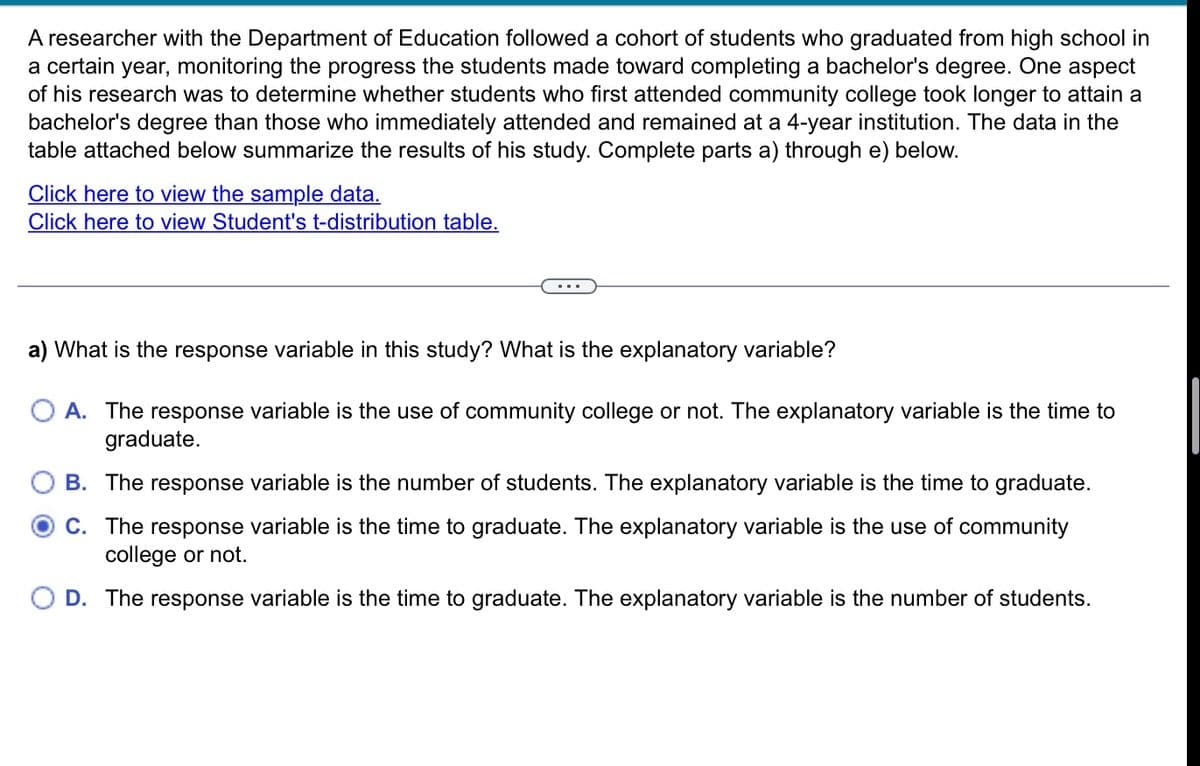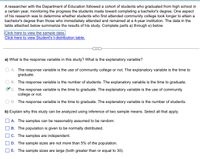A researcher with the Department of Education followed a cohort of students who graduated from high school in a certain year, monitoring the progress the students made toward completing a bachelor's degree. One aspect of his research was to determine whether students who first attended community college took longer to attain a bachelor's degree than those who immediately attended and remained at a 4-year institution. The data in the table attached below summarize the results of his study. Complete parts a) through e) below. Click here to view the sample data. Click here to view Student's t-distribution table. a) What is the response variable in this study? What is the explanatory variable? A. The response variable is the use of community college or not. The explanatory variable is the time to graduate. B. The response variable is the number of students. The expl ory variable is the time to graduate. O C. The response variable is the time to graduate. The explanatory variable is the use of community college or not. D. The response variable is the time to graduate. The explanatory variable is the number of students.
A researcher with the Department of Education followed a cohort of students who graduated from high school in a certain year, monitoring the progress the students made toward completing a bachelor's degree. One aspect of his research was to determine whether students who first attended community college took longer to attain a bachelor's degree than those who immediately attended and remained at a 4-year institution. The data in the table attached below summarize the results of his study. Complete parts a) through e) below. Click here to view the sample data. Click here to view Student's t-distribution table. a) What is the response variable in this study? What is the explanatory variable? A. The response variable is the use of community college or not. The explanatory variable is the time to graduate. B. The response variable is the number of students. The expl ory variable is the time to graduate. O C. The response variable is the time to graduate. The explanatory variable is the use of community college or not. D. The response variable is the time to graduate. The explanatory variable is the number of students.
Algebra & Trigonometry with Analytic Geometry
13th Edition
ISBN:9781133382119
Author:Swokowski
Publisher:Swokowski
Chapter7: Analytic Trigonometry
Section7.2: Trigonometric Equations
Problem 97E
Related questions
Question
HW10Q10PA

Transcribed Image Text:A researcher with the Department of Education followed a cohort of students who graduated from high school in
a certain year, monitoring the progress the students made toward completing a bachelor's degree. One aspect
of his research was to determine whether students who first attended community college took longer to attain a
bachelor's degree than those who immediately attended and remained at a 4-year institution. The data in the
table attached below summarize the results of his study. Complete parts a) through e) below.
Click here to view the sample data.
Click here to view Student's t-distribution table.
a) What is the response variable in this study? What is the explanatory variable?
A. The response variable is the use of community college or not. The explanatory variable is the time to
graduate.
B. The response variable is the number of students. The explanatory variable is the time to graduate.
O C. The response variable is the time to graduate. The explanatory variable is the use of community
college or not.
D. The response variable is the time to graduate. The explanatory variable is the number of students.
Expert Solution
This question has been solved!
Explore an expertly crafted, step-by-step solution for a thorough understanding of key concepts.
This is a popular solution!
Trending now
This is a popular solution!
Step by step
Solved in 2 steps

Follow-up Questions
Read through expert solutions to related follow-up questions below.
Follow-up Question
HW10Q10PTB

Transcribed Image Text:A researcher with the Department of Education followed a cohort of students who graduated from high school in
a certain year, monitoring the progress the students made toward completing a bachelor's degree. One aspect
of his research was to determine whether students who first attended community college took longer to attain a
bachelor's degree than those who immediately attended and remained at a 4-year institution. The data in the
table attached below summarize the results of his study. Complete parts a) through e) below.
Click here to view the sample data.
Click here to view Student's t-distribution table.
a) What is the response variable in this study? What is the explanatory variable?
A. The response variable is the use of community college or not. The explanatory variable is the time to
graduate.
B. The response variable is the number of students. The explanatory variable is the time to graduate.
C. The response variable is the time to graduate. The explanatory variable is the use of community
college or not.
D. The response variable is the time to graduate. The explanatory variable is the number of students.
b) Explain why this study can be analyzed using inference of two sample means. Select all that apply.
A. The samples can be reasonably assumed to be random.
B. The population is given to be normally distributed.
C. The samples are independent.
D. The sample sizes are not more than 5% of the population.
E. The sample sizes are large (both greater than or equal to 30).
Solution
Recommended textbooks for you

Algebra & Trigonometry with Analytic Geometry
Algebra
ISBN:
9781133382119
Author:
Swokowski
Publisher:
Cengage

Linear Algebra: A Modern Introduction
Algebra
ISBN:
9781285463247
Author:
David Poole
Publisher:
Cengage Learning

Algebra & Trigonometry with Analytic Geometry
Algebra
ISBN:
9781133382119
Author:
Swokowski
Publisher:
Cengage

Linear Algebra: A Modern Introduction
Algebra
ISBN:
9781285463247
Author:
David Poole
Publisher:
Cengage Learning